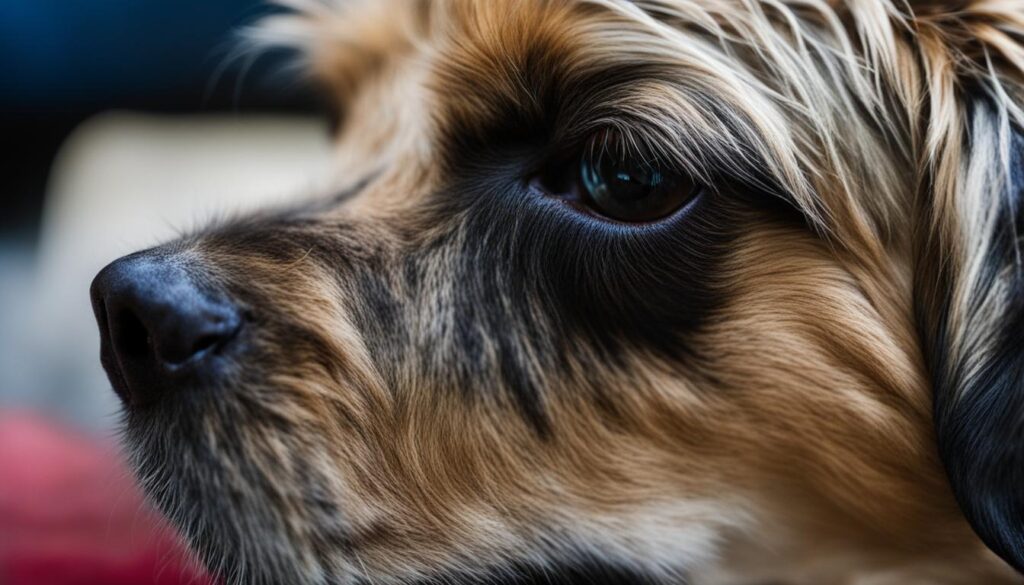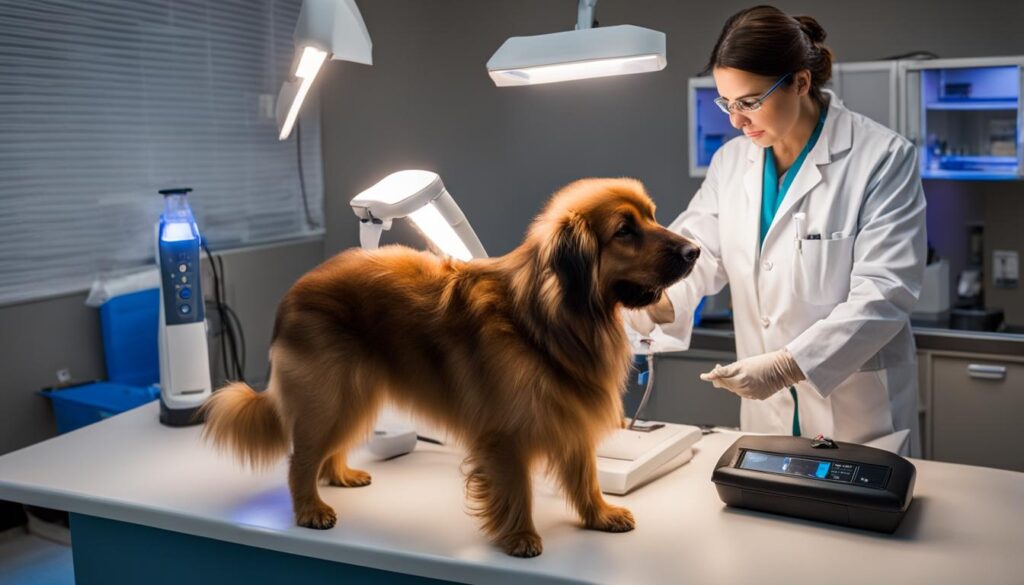Ringworm Symptoms in Dogs Uncovered
Ringworm is a common fungal infection in dogs that can cause circular areas of hair loss, scabby or inflamed skin, and dry, brittle hair. It is important for dog owners to be able to identify the symptoms of ringworm to prevent the spread of the infection to humans or other pets. The fungus responsible for ringworm in dogs can be spread through direct contact with infected animals or objects that have been contaminated.
Key Takeaways:
- Ringworm is a fungal infection that affects dogs, causing circular areas of hair loss and inflamed skin.
- Identifying the symptoms of ringworm is crucial in preventing its spread to humans or other pets.
- Direct contact with infected animals or contaminated objects can transmit the fungus responsible for ringworm in dogs.
- Seeking veterinary attention for diagnosis and treatment is recommended for dogs showing signs of ringworm.
- Proper treatment protocols and preventive measures can help control the spread of ringworm and protect the health of dogs and humans.
What is Ringworm and How is it Spread?
Ringworm is a common fungal infection that affects dogs, and contrary to its name, it is not caused by a worm. The infection is caused by fungi, specifically Microsporum canis, Microsporum gypseum, and Trichophyton mentagrophytes. Ringworm typically grows in the outermost layer of a dog’s skin and hair follicles, leading to various symptoms and discomfort.
This fungal infection can spread through direct contact with infected animals or objects that have been contaminated. The fungus releases spores that can persist in the environment for up to 18 months, resulting in easy transmission through shedding or breaking of infected hairs. It’s crucial for dog owners to understand how ringworm spreads to prevent its further dissemination.
| Causes of Ringworm in Dogs | How Ringworm is Spread |
|---|---|
| • Fungi: Microsporum canis, Microsporum gypseum, and Trichophyton mentagrophytes | • Direct contact with infected animals |
| • Contact with contaminated objects | |
| • Shedding or breaking of infected hairs |
Symptoms and Appearance of Ringworm in Dogs
The most common symptom of ringworm in dogs is circular areas of hair loss, which may start to heal in the center as they enlarge, creating a patchy appearance. The affected areas of skin may also be scabby or inflamed, and the hair follicles can become dry and brittle. It’s important to note that ringworm usually does not cause itching in dogs. The appearance and symptoms of ringworm can vary depending on the severity of the infection and the individual dog.
To give you a better understanding of the symptoms and appearance of ringworm in dogs, here is a detailed breakdown:
1. Circular Areas of Hair Loss
The most telling sign of ringworm in dogs is the development of circular areas of hair loss. These circular patches may start small but gradually enlarge over time. The affected skin may appear red, scaly, or crusty.
2. Patchy Appearance
As the circular patches of hair loss enlarge, they often start to heal in the center, resulting in a patchy appearance where the edges are most affected. This distinctive pattern is a characteristic feature of ringworm in dogs.
3. Scabby or Inflamed Skin
The areas of skin affected by ringworm may become scabby or inflamed. This can lead to discomfort for the dog and can be observed as redness, swelling, or lesions in the affected areas.
4. Dry and Brittle Hair Follicles
Ringworm can cause the hair follicles in the affected areas to become dry and brittle. This can result in hair breakage or easy plucking of the hair from the affected areas.
While these symptoms are commonly associated with ringworm in dogs, it’s important to remember that the appearance and severity of the infection can vary from dog to dog. It is always recommended to consult with a veterinarian for an accurate diagnosis and appropriate treatment.

Diagnosis and Treatment of Ringworm in Dogs
When it comes to the diagnosis of ringworm in dogs, veterinarians utilize a combination of physical examination and diagnostic tests to confirm the presence of the fungal infection.
During the physical examination, a veterinarian will closely inspect the affected areas of a dog’s skin and hair, looking for characteristic symptoms such as circular areas of hair loss, scabs, and inflammation.
To further confirm the diagnosis, a fungal culture may be performed. This involves collecting samples of affected hair or skin and placing them in a special culture medium to encourage the growth of any fungal organisms present. The samples are then observed for fungal growth, which can take up to several weeks.
In some cases, a veterinarian may also utilize a Wood’s lamp, a specialized ultraviolet light, to examine the affected areas. Certain types of ringworm fungi will fluoresce under the Wood’s lamp, aiding in diagnosis.

Once a definitive diagnosis has been made, treatment for ringworm in dogs can begin. It typically involves a multi-step approach to effectively eliminate the fungal infection and prevent its spread.
The first step often involves topical therapy. This includes applying antifungal creams, ointments, or medicated shampoos directly to the affected areas. These topical treatments help to kill the fungus on the skin surface and promote healing.
In addition to topical therapy, oral medications may be prescribed to address the underlying infection systemically. These medications help to combat the ringworm fungus from within the dog’s body, further aiding in the healing process.
Environmental decontamination is another essential aspect of ringworm treatment. It involves thoroughly cleaning and disinfecting living spaces, bedding, toys, and other objects that may have come into contact with the infected dog. This helps to remove any lingering fungal spores and prevent re-infection or transmission to other animals or humans.
It is crucial for dog owners to follow the prescribed treatment plan for the recommended duration, even if symptoms begin to improve. Ringworm can be persistent and easily spread if not properly treated, so adherence to the veterinary guidance is vital for successful treatment and prevention of recurrence.
Prevention and Controlling the Spread of Ringworm in Dogs
While ringworm can be difficult to prevent, there are some steps dog owners can take to minimize the risk of infection.
- Thoroughly clean the environment: Regularly vacuuming and disinfecting surfaces can help eliminate fungal spores that may cause ringworm. Pay extra attention to areas where your dog spends the most time, such as their bedding, toys, and favorite resting spots.
- Keep infected dogs separated: If you suspect that your dog has ringworm, it is essential to keep them separated from other pets to prevent the spread of the infection. Avoid sharing bedding, grooming tools, or any other items that may come into contact with the infected dog’s skin or hair.
- Follow veterinary guidance: Seeking professional veterinary care is crucial in diagnosing and treating ringworm in dogs. Your veterinarian will provide specific instructions on the appropriate treatment methods and medications to effectively manage the infection. It is important to follow their guidance closely to minimize the risk of spreading ringworm.
Even after treatment, dogs can still be contagious, so taking precautions is necessary to prevent the spread of ringworm:
- Keep infected dogs isolated until they have completed the entire course of treatment and have received clearance from the veterinarian.
- Practice good hygiene: Wash your hands thoroughly after handling your dog, especially if you suspect they have ringworm. This can prevent the transfer of fungal spores from your dog to your own skin or other surfaces.
- Regularly clean and sanitize your dog’s belongings: Wash their bedding, toys, and any other items that come into contact with the infected dog’s skin or hair. Use hot water and disinfectants to ensure proper cleaning.
Precautions for preventing ringworm in dogs:
“Taking proactive measures to prevent ringworm in dogs can help protect their health and the well-being of your entire household.”
By implementing these preventive measures and closely following the guidance of your veterinarian, you can significantly reduce the risk of ringworm in your dog and control its spread.
| Prevention Tips | Effects |
|---|---|
| Thorough cleaning and disinfection | Eliminates fungal spores and reduces the risk of infection |
| Isolating infected dogs | Prevents the spread of ringworm to other pets |
| Following veterinary guidance | Ensures proper diagnosis, treatment, and prevention strategies |
| Practicing good hygiene | Minimizes the risk of transferring fungal spores |
| Regular cleaning and sanitization | Reduces the presence of fungal spores in the environment |
Conclusion
In conclusion, ringworm is a common fungal infection in dogs that can result in hair loss, scabby or inflamed skin, and dry, brittle hair. Recognizing the symptoms of ringworm is crucial for dog owners to seek veterinary attention promptly. By following proper treatment protocols and taking preventive measures, the spread of ringworm can be controlled, ensuring the health and well-being of both dogs and humans.
If you notice circular areas of hair loss, inflamed skin, or changes in your dog’s hair texture, it is important to consult with your veterinarian. Early diagnosis and treatment are key to managing ringworm effectively. Veterinarians can perform diagnostic tests to confirm the presence of ringworm and prescribe a suitable treatment plan, which may include topical creams, oral medications, and environmental decontamination.
To prevent the spread of ringworm, it is crucial to keep infected dogs separated from other pets and to thoroughly clean and disinfect the environment. Regular vacuuming, washing bedding, and disinfecting surfaces can help eliminate fungal spores and minimize the risk of infection. It is also important to note that even after treatment, dogs can still be contagious. Therefore, ongoing vigilance and precautionary measures should be taken to prevent the recurrence and spread of ringworm.
FAQ
What are the symptoms of ringworm in dogs?
The symptoms of ringworm in dogs include circular areas of hair loss, scabby or inflamed skin, and dry, brittle hair. The affected areas may start to heal in the center as they enlarge, creating a patchy appearance.
How is ringworm spread in dogs?
Ringworm in dogs is primarily spread through direct contact with infected animals or objects that have been contaminated. The fungal spores can remain viable for up to 18 months and can be easily spread through shedding or breaking of infected hairs.
What does ringworm look like on dogs?
On dogs, ringworm appears as circular areas of hair loss, scabby or inflamed skin, and dry, brittle hair. The affected areas may have a patchy appearance and do not usually cause itching in dogs.
How is ringworm diagnosed in dogs?
Veterinarians can diagnose ringworm in dogs through a physical examination and diagnostic tests, such as a fungal culture or examination of infected hairs under a special ultraviolet light.
How is ringworm in dogs treated?
Treatment for ringworm in dogs usually involves a multi-step approach, including topical therapy with creams or medicated shampoos, oral medications, and environmental decontamination. Follow the prescribed treatment plan for the recommended duration to ensure effective treatment.
How can ringworm in dogs be prevented?
While ringworm can be difficult to prevent, there are steps dog owners can take to minimize the risk of infection. Thoroughly cleaning the environment, keeping infected dogs separated from other pets, and following veterinary guidance for treatment and prevention can help prevent the spread of ringworm.


